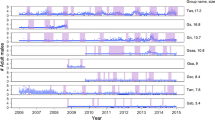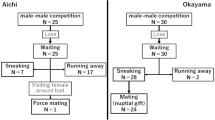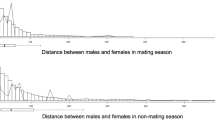Abstract
Observations on a habituated troop of samango monkeys (Cercopithecus mitis)revealed that lone males did not achieve significant mating opportunities during a breeding season in which few females were sexually receptive. This stood in contrast to the previous year and was associated with the maintenance of shorter resident male-female distances, confirming suggestions that the reproductive benefits of residency are associated primarily with low numbers of simultaneously receptive females. At the same time, lone males made no attempt to challenge the resident male physically in order to gain access to females. Given the presence of a stable bachelor group and the absence of other, transient, males, these data are used to argue for male mating strategies that are sensitive to regional and temporal variability in the availability of receptive females.
Similar content being viewed by others
References
Andelman, S. J. (1986). Ecological and social determinants of cercopithecine mating patterns. In Rubenstein, D. I., and Wrangham, R. W. (eds.),Ecological Aspects of Vertebrate Social Evolution, Princeton University Press, Princeton, N.J., pp. 201–216.
Butynski, T. M. (1982). Harem male replacement and infanticide in the blue monkey (Cercopithecus mitis stuhlmannt) in the Kibale Forest, Uganda.Am. J. Primatol. 3: 1–22.
Butynski, T. M. (1988). Comparative ecology of blue monkeys (Cercopithecus mitis) in high and low density subpopulations (in press).
Chism, J. B., and Rowell, T. E. (1986). Mating and residence patterns of male patas monkeys.Ethology 72: 31–39.
Cords, M. (1984). Mating patterns and social structure in redtail monkeys (Cercopithecus ascanius).Z. Tierpsychol. 64: 313–329.
Cords, M. (1986). Forest guenons and patas monkeys: Male-male competition in one-male groups. In Smuts, B. B., Cheney, D. L., Seyfarth, R. M., Wrangham, R. W., and Struhsaker, T. T. (eds.),Primate Societies, University of Chicago Press, Chicago, pp. 98–111.
Cords, M. (1988). Mating systems of forest guenons: A preliminary review. In Gautier-Hion, A., Bourliere, F., Gautier, J.-P., and Kingdon, J. (eds.),A Primate Radiation: Evolutionary Biology of the African Guenons, Cambrdige University Press, Cambridge pp. 323–339.
Cords, M., and Rowell, T. E. (1986). Group fission in blue monkeys of the Kakamega Forest, Kenya.Folia Primatol. 46: 70–82.
Cords, M., and Rowell, T. E. (1987). Birth intervals of cercopithecus monkeys of the Kakamega Forest, Kenya.Primates 28: 277–281.
Cords, M., Mitchell, B. J., Tsingalia, H. M., and Rowell, T. E. (1986). Promiscuous mating among blue monkeys in the Kakamega Forest, Kenya.Etology 72: 214–226.
Dunbar, R. I. M. (1982). Intraspecific variations in mating strategy. In Bateson, P. P. G., and Klopfer, P. H. (eds.), Perspectives in Ethology, Plenum Press, New York, Vol. 5, pp. 385–431.
Dunbar, R. I. M. (1988).Primate Social Systems, Croom Helm, London.
Else, J. G., Eley, R. M., Suleman, M. A., and Lequin, R. M. (1985). Reproductive biology of Sykes and blue monkeys (Cercopithecus mitis).Am. J. primatol. 9: 189–196.
Emlen, S. T., and Oring, L. (1977). Ecology, sexual selection and the evolution of mating systems.Science 197: 215–223.
Hall, K. R. L. (1965). Behaviour and ecology of the wild patas monkey,Erylhrocebus paras, in Uganda.J. Zool. (London) 148: 15–87.
Harding, R. S. O., and Olson, D. K. (1986). Patterns of mating among male patas monkeys (Erythrocebus patas). In Kenya.Am. J. Primatol. 11: 343–358.
Henzi, S. P., and Lawes, M. (1987). Breeding season influxes and the behaviour of adult male samango monkeys (Cercopithecus mitis albogularis).Folia primatol. 48: 125–136.
Hogg, J. T. (1984). Mating in bighorn sheep: multiple creative male strategies.Science 225: 526–529.
Laws, J. W., and Vonder Haar Laws, J. (1984). Social-interactions’among male langurs (Presbytis entellus) at Rajaji Wildlife Sanctuary.Int. J. Primatol. 5: 31–50.
Moore, J. (1985).Demography and Sociality in Primates, Ph.D. thesis, Harvard University, Cambridge.
Rajpurohit, L. S., and Mohnot, S. M. (1988). Fate of ousted male residents of one-male bisexual troops of hanuman langurs (Presbytis entellus) at Jodhpur, Rajasthan (India).Hum. Evol. (in press).
Rowell, T. E. (1988). Beyond the one-male group.Behaviour 104: 189–201.
Rubenstein, D. I. (1980). On the evolution of alternative mating strategies. In Staddon, J. E. R. (ed.),Limits to Action, Academic Press, London, pp. 65–100.
Rudran, R. (1978). Socioecology of the blue monkey (Cercopithecus mitis stuhlmanni) of the Kibale Forest, Uganda.Smithsonian Contrib. Zool. 249.
Smuts, B. B. (1985).Sex and Friendship in Baboons, Aldine, Chicago.
Sommer, V. (1988). Male competition and coalition in langurs (Presbytis entellus) at Jodhpur, Rajasthan, India.Hum. Evol. (in press).
Struhsaker, T. T. (1969). Correlates of ecology and social organization among African cercopithecines.Folia primatol. 11: 80–118.
Struhsaker, T. T., and Leland, L. (1979). Socioecology of five sympatric monkey species in the Kibale Forest, Uganda. In Rosenblatt, J. S., Hinde, R. A., Beer, C., and Busnel, M.-C. (Eds.),Advances in the Study of Behavior, Academic Press, New York, Vol. 9, pp. 159–228.
Strum, S. C. (1982). Agonistic dominance in male baboons: An alternative view.Int. J. Primatol. 3: 175–202.
Tsingalia, H. M., and Rowell, T. E. (1984). The behavior of adult male blue monkeys.Z. Tierpsychol. 64: 253–268.
Wittenberger, J. F. (1980). Group size and polygamy in social mammals.Am. Nat. 115: 197–222.
Wrangham, R. W. (1980). An ecological model of female-bonded primate groups.Behaviour 75: 262–300.
Author information
Authors and Affiliations
Rights and permissions
About this article
Cite this article
Henzi, S.P., Lawes, M. Strategic responses of male samango monkeys (Cercopithecus mitis) to a decline in the number of receptive females. Int J Primatol 9, 479–495 (1988). https://doi.org/10.1007/BF02736221
Received:
Revised:
Issue Date:
DOI: https://doi.org/10.1007/BF02736221




